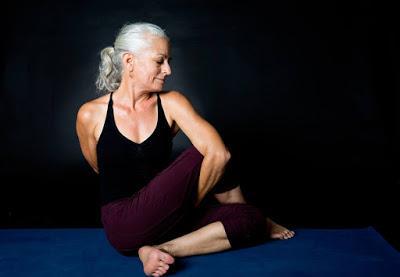
Joy Sassoon, Age 60
Your respiratory system is essential to life, and a completely healthy chest and lungs make a full life more likely. Today, we are recommending techniques for supporting the health of your respiratory system, whether you are healthy and want to stay that way, or whether you have a respiratory disorder or medical condition that directly affects or may eventually affect your respiratory system. These recommendations apply to people who:- Are currently healthy
- Are sedentary but wanting to improve your respiratory system
- Are ex-smokers
- Have lung diseases, such as asthma, exercise-induced asthma, and chronic obstructive pulmonary disease (emphysema)
- Have been exposed to lung toxins, such as asbestos
- Have heart conditions such as congestive heart failure that directly affect the lungs or heart valve problems that may eventually affect the respiratory system
How Often to Practice. If you are healthy, practice up to six days a week, alternating days of active practice with days of gentle and restorative practice. If you are currently experiencing respiratory problems, try practicing four days a week, also alternating between active days with restorative days. If you see positive changes, slowly add more days of practice. Breath Awareness. Practicing simple breath awareness can reveal breathing habits that you are not currently aware of. You can practice breath awareness in both active poses and relaxation poses to reveal breathing patterns you might want to change, such as chronic shallow, rapid breathing that might not be so healthy during Sun Salutations or physically demanding postures. You may decide to skip this technique However, if you are experiencing shortness of breath, such as an acute asthma episode, you may wish to skip this technique, as focusing on your breath may make you more anxious. Balanced Practice. Because one of the primary benefits of yoga asana for your respiratory system function is releasing any tension in the muscles and fascia around the chest region, we recommend practicing a balances sequence that includes: forward bends to open your back, backbends to open your chest, side bends to open the sides of your torso, and twists to release tension from the diagonal muscles and fascia around your chest. Include a mix of both dynamic and static poses. If you have been sedentary for a period, an asana practice that includes these elements can help you regain strength in all the muscles that assist in breathing and improve your overall lung capacity. Round out your practice by including breath practices, restorative poses, and stress management practices.Breath Practices. Since there are times in your everyday life when you need to breath fast and deep and other times when you should be resting and breathing comfortably, your breath practices can help support whatever context you find yourself. So you should do both stimulating as well as relaxing breath practices. For relaxing your respiratory system a good way to start is by using a 1:2 ratio breath or by slowing and slightly deepening both your inhalation and exhalation equally. To improve your total lung capacity, start with an even breath of 2 seconds in/out,. Then, gradually over time work up to 6 seconds or more in/out, up to your tolerance. Dynamic Poses. Focus on dynamic poses that stretch and strengthen the muscles and tissues around your chest area. For example, moving with your breath between Mountain pose, Arms Overhead pose, and Standing Forward Bend and back stretches and strengthens both the front and back of your chest. Moving between Arms Overhead pose to Crescent Moon pose (the side bending version of Arms Overhead pose) stretches and strengthens the sides of your chest. And a dynamic seated twist stretches and strengthens the diagonal muscles of your torso. Start with 6 rounds in and out, and work up to 10 rounds. Initially move at a comfortable breath pace. Experiment with slowing down your breath and movement pace or speeding both up gradually to train the body for different situations. Static Poses. Focus on poses either stretch or strengthen your torso, including forward bends, backbends, and twists, or standing poses that include or combine those movements. Some examples are Standing Forward Bend (Uttanasana), Triangle pose, Extended Side Angle pose, Warrior 1, Cobra pose variations, Marichyasana 3 or Easy Sitting Twist. While passive stretches such as a Supported Backbend will only improve flexibility, many active poses can improve both flexibility and strength. For example, Triangle pose strengthens some muscles along the slides of the torso while also stretching others. So for improvements in flexibility, combine those active poses with passive, supported stretches, such as a Supported Backbend or Reclined Twist. If you are new to practice or have a respiratory condition, start off with short holds 10 seconds. Then gradually work up to 30 seconds. From there, to maximize improvements in strength in flexibility and strength, aim for eventual holds of 90 seconds or more. Restorative Poses. In general, restful poses are beneficial to the overall functioning of your respiratory system, as they rest your overall respiratory system and lower stress levels. We recommend practicing restorative poses that gently stretch and open your torso area but do not trigger shortness of breath, such as Supported Backbend, Childs’s pose with or without a bolster, and Legs up the Wall pose with arms to your sides or overhead. If focusing on your breath in these poses causes anxiety, try any focusing instead on a different physical sensation, an image, or a mantra. Stress Management. Reducing stress has positive effect on your immune system, which could lower your chances of getting infections of the respiratory tract, from the nose and mouth all the way into the deep lungs. In addition, your lungs need downtime to rest and repair, so spending time in Rest and Digest mode provides a beneficial break for them. And for those with chronic respiratory system conditions, practicing regular stress management can improve the quality of your life by reducing anxiety and fear. Use any of the stress management practices we have described elsewhere (see The Relaxation Response and Yoga) that you can tolerate and that also lead to improvements in your breathing.Subscribe to Yoga for Healthy Aging by Email ° Follow Yoga for Healthy Aging on Facebook ° Join this site with Google Friend Connect

